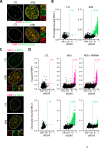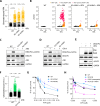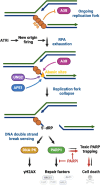This is a preprint.
ATR safeguards replication forks against APOBEC3B-induced toxic PARP1 trapping
- PMID: 39605722
- PMCID: PMC11601322
- DOI: 10.1101/2024.11.14.623607
ATR safeguards replication forks against APOBEC3B-induced toxic PARP1 trapping
Update in
-
Mechanism of DNA replication fork breakage and PARP1 hyperactivation during replication catastrophe.Sci Adv. 2025 Apr 18;11(16):eadu0437. doi: 10.1126/sciadv.adu0437. Epub 2025 Apr 16. Sci Adv. 2025. PMID: 40238882
Abstract
ATR is the master safeguard of genomic integrity during DNA replication. Acute inhibition of ATR with ATR inhibitor (ATRi) triggers a surge in origin firing, leading to increased levels of single-stranded DNA (ssDNA) that rapidly deplete all available RPA. This leaves ssDNA unprotected and susceptible to breakage, a phenomenon known as replication catastrophe. However, the mechanism by which unprotected ssDNA breaks remains unclear. Here, we reveal that APOBEC3B is the key enzyme targeting unprotected ssDNA at replication forks, triggering a reaction cascade that induces fork collapse and PARP1 hyperactivation. Mechanistically, we demonstrate that uracils generated by APOBEC3B at replication forks are removed by UNG2, creating abasic sites that are subsequently cleaved by APE1 endonuclease. Moreover, we demonstrate that APE1-mediated DNA cleavage is the critical enzymatic step for PARP1 trapping and hyperactivation in cells, regardless of how abasic sites are generated on DNA. Finally, we show that APOBEC3B-induced toxic PARP1 trapping in response to ATRi drives cell sensitivity to ATR inhibition, creating to a context of synthetic lethality when combined with PARP inhibitors. Together, these findings reveal the mechanisms that cause replication forks to break during replication catastrophe and explain why ATRi-treated cells are particularly sensitive to PARP inhibitors.
Conflict of interest statement
DECLARATION OF INTERESTS The authors declare no competing interests.
Figures







Similar articles
-
Mechanism of DNA replication fork breakage and PARP1 hyperactivation during replication catastrophe.Sci Adv. 2025 Apr 18;11(16):eadu0437. doi: 10.1126/sciadv.adu0437. Epub 2025 Apr 16. Sci Adv. 2025. PMID: 40238882
-
ATR protects ongoing and newly assembled DNA replication forks through distinct mechanisms.Cell Rep. 2023 Jul 25;42(7):112792. doi: 10.1016/j.celrep.2023.112792. Epub 2023 Jul 16. Cell Rep. 2023. PMID: 37454295 Free PMC article.
-
APOBEC3A and APOBEC3B Activities Render Cancer Cells Susceptible to ATR Inhibition.Cancer Res. 2017 Sep 1;77(17):4567-4578. doi: 10.1158/0008-5472.CAN-16-3389. Epub 2017 Jul 11. Cancer Res. 2017. PMID: 28698210 Free PMC article.
-
PARP1 roles in DNA repair and DNA replication: The basi(c)s of PARP inhibitor efficacy and resistance.Semin Oncol. 2024 Feb-Apr;51(1-2):2-18. doi: 10.1053/j.seminoncol.2023.08.001. Epub 2023 Sep 6. Semin Oncol. 2024. PMID: 37714792 Review.
-
Positioning loss of PARP1 activity as the central toxic event in BRCA-deficient cancer.DNA Repair (Amst). 2024 Dec;144:103775. doi: 10.1016/j.dnarep.2024.103775. Epub 2024 Oct 19. DNA Repair (Amst). 2024. PMID: 39461277 Review.
References
Publication types
Grants and funding
LinkOut - more resources
Full Text Sources
Research Materials
Miscellaneous
